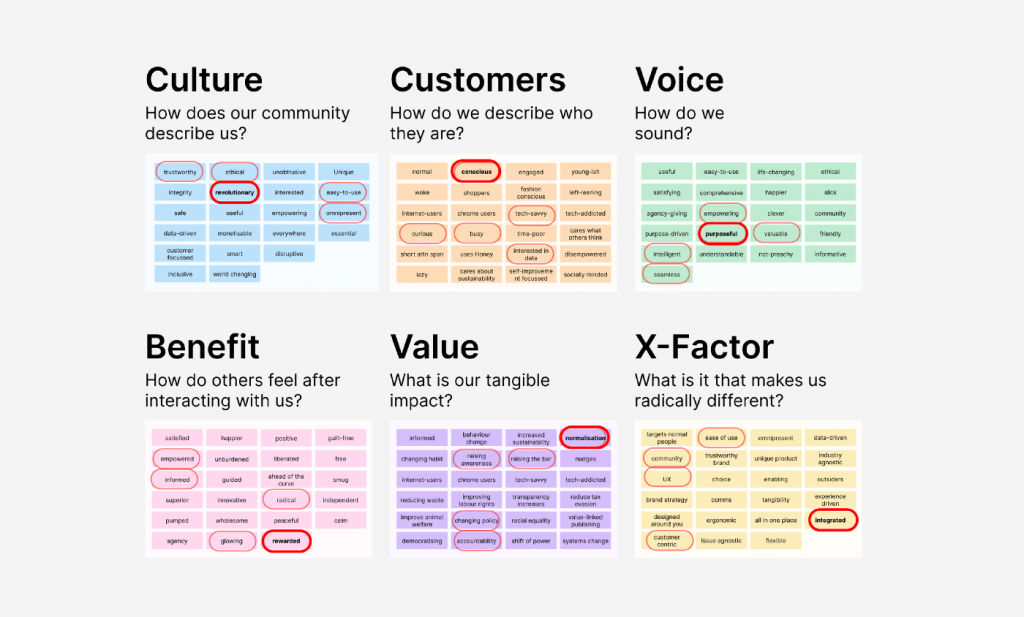Role of Branding: Building a Brand That Stands Out
In the ever-evolving digital landscape, where the competition is cutthroat and the attention span of consumers shorter than a blink of an eye, creating a brand that stands out has become a necessary feat. With the proliferation of information and choices readily available at the click of a button, the challenge lies in capturing potential customers' attention and turning that attention into business success.
The role of branding today must be addressed. According to Officite, 87% of consumers said that they would choose a company over a competitor based on the reputation of the company's brand. This powerful statistic points to the significant influence that branding has on business success.
We will explore the role of branding in the digital age in-depth. We will dive into the nuts and bolts of branding, dissecting the core elements of a strong brand and providing tips for creating a brand strategy that resonates with your target audience.
Table of Contents
Understanding Branding in the Digital Age

Getting noticed in the crowded digital space is incredibly challenging without proper branding. In the digital age, where information is abundant and easily accessible, businesses must create brand identities that distinguish them from their competition. In this article, we will discuss the role of branding in the digital age, including its definition, impact on technology and social media, and how it has evolved from product-centric to customer-centric.
Defining Branding in the Digital Age
Branding is creating a unique identity for a business and communicating it to its target audience. In the digital age, branding goes beyond logos and design. It includes the personality, values, and mission of a business. Brands that communicate their identity effectively have a higher chance of capturing the attention and loyalty of their target audience.
The Impact of Technology and Social Media on Branding
Technology and social media have revolutionised the way businesses approach branding. With the rise of smartphones and the internet, consumers are always connected, and businesses must find new ways to engage with them.
Social media platforms such as Facebook, Instagram, and Twitter offer businesses a powerful tool to communicate with their audience. Creating engaging content and interacting with customers in real-time can help companies to build brand recognition, trust, and loyalty. According to Statista, social media users worldwide are projected to reach 5.85 billion by 2027, highlighting the digital space's potential for businesses to reach a broad audience.
Technology has allowed businesses to create new and innovative ways to engage with their customers, such as augmented reality, voice search, and chatbots. These new technologies enable companies to create immersive brand experiences and streamline customer interactions, increasing customer satisfaction and loyalty.
The Evolution of Branding from Product-Centric to Customer-Centric
Branding has come a long way from the traditional product-centric approach, which focuses on selling products to customers. Today, the rise of customer-centric branding has become increasingly critical as businesses focus on creating experiences that connect with their audience.
Customer-centric branding means creating experiences that revolve around customers' aspirations, expectations, and emotions. Customer-centric branding involves understanding the target audience's needs and interests and crafting brand identities that align with their values and beliefs. The customer-centric approach has become a crucial aspect of branding in the digital age. The focus is on creating meaningful connections with customers beyond simply selling products.
The shift towards customer-centric branding requires businesses to adopt a more empathetic approach to customers. This means creating personalised experiences, providing exceptional customer service, and establishing brand loyalty through trust and reliability. A customer-centric approach can tremendously impact business success, with studies showing that customer-centric companies are 60% more profitable than those not focusing on the customer.
The Importance of Branding for Business Success

A strong brand can be the difference between a thriving business and one that fades into obscurity. Let's explore the role of branding in building a competitive advantage, how branding can boost customer loyalty and retention, the correlation between branding and business value, and the benefits of investing in branding in the digital age.
Examining the Role of Branding in Building a Competitive Advantage
Branding can help businesses develop a competitive advantage by differentiating their product development company or services. A strong brand can attract customers and communicate a level of quality, trust, and reliability that can set a business apart. Competitors may offer similar products or services, but the unique value proposition offered by a strong brand can give a company a significant advantage in a crowded market.
How Branding Can Boost Customer Loyalty and Retention
A strong brand can help build customer loyalty and retention. Customers who identify with a brand develop an emotional connection beyond simply buying a product. This emotional connection can lead to long-term commitment, with customers choosing a brand over its competitors. Moreover, loyal customers are more likely to refer a brand to their peers, boosting brand recognition and sales.
Unpacking the Correlation Between Branding and Business Value
Building a solid brand can significantly impact a business's value in the short and long term. A strong brand can enhance the business's reputation, increasing revenue and profits. Furthermore, strong brands have a higher perceived value among customers, leading to premium pricing and increased profitability. A study by Interbrand found that the world's 100 top brands have a brand value of over $3 trillion, highlighting the correlation between branding and business value.
The Benefits of Investing in Branding in the Digital Age
In the digital age, investing in branding has become even more critical. The proliferation of information and choices available at consumers' fingertips makes capturing and retaining customers' attention challenging. A strong brand communicating its values, personality, and mission can break through the digital noise and create a lasting impression.
Investing in branding can also help businesses stay relevant in an ever-changing market. As businesses evolve and competition intensifies, a strong brand can provide the foundation for growth and expansion. Customers' needs and interests continually evolve, and a well-crafted brand can adapt to these changes to remain relevant and appealing.
Critical Elements of a Strong Brand

A strong brand can be the difference between a thriving business and one that fades into obscurity. Building a strong brand requires a deliberate effort to create a unique identity that resonates with your target audience.
Let's explore the critical elements of a strong brand, including creating a brand identity that resonates with your target audience, establishing brand personality and voice, positioning your brand through strategic messaging and marketing, creating a cohesive brand experience across touchpoints, and aligning your brand with your business values and reputation.
Creating a Brand Identity that Resonates with Your Target Audience
A strong brand identity is vital to building a positive reputation among your target audience. To create a brand identity that resonates with your audience, you must understand their needs, interests, and aspirations. Your brand should reflect the values and beliefs of your target market and communicate your unique value proposition. Creating a solid brand identity involves:
- Creating a compelling tagline.
- Designing a memorable logo.
- Establishing a consistent colour palette and visual identity.
Establishing Brand Personality and Voice
Brand personality and voice refer to the human characteristics that a brand uses to connect with its audience. A strong personality and voice can humanise your brand, making it more relatable and memorable. Developing a solid brand personality involves understanding your brand's values and mission and communicating them in a way that aligns with your audience's interests and perspectives. Establishing a unique brand voice involves developing a tone that resonates with your audience and reflects your brand's personality.
Positioning Your Brand Through Strategic Messaging and Marketing
Positioning your brand through strategic messaging and marketing involves developing a clear message that communicates the value of your brand to your target audience. The statement should be concise, unique, and relevant to your audience's interests and needs. When creating messaging and marketing materials, it is critical to consider your brand's positioning. By communicating your unique value proposition and positioning your brand relative to your competition, you can differentiate your brand and create a lasting impact.
Creating a Cohesive Brand Experience Across Touchpoints
A strong brand experience involves creating a consistent impression across all touchpoints, including social media, website, packaging, and customer service. Creating a cohesive brand experience requires a coherent design, visual identity, and consistency in messaging and customer interactions. A cohesive brand experience can build brand recognition and customer loyalty, increasing sales and business growth.
Aligning Your Brand with Your Business Values and Reputation
Your brand should reflect your business's values and reputation. By aligning your brand with your business values and reputation, you can build a strong reputation and establish trust with your audience. A brand that aligns with a business's values and standing can also attract and retain employees who share those values and beliefs.
In conclusion, building a strong brand requires a deliberate effort to create a unique identity that resonates with your target audience. Critical elements of a strong brand include:
- Creating a brand identity that resonates with your target audience.
- Establishing brand personality and voice.
- Positioning your brand through strategic messaging and marketing.
- Creating a cohesive brand experience across touchpoints.
- Aligning your brand with your business values and reputation.
By focusing on these critical elements, businesses can create strong brands that stand the test of time and drive business success.
Tips for Building a Strong Brand in the Digital Age

Building a solid brand in the digital age requires businesses to understand their target audience, develop a comprehensive branding strategy, create a unique visual identity, build a robust online presence, and engage with customers to build trust and loyalty. Let's explore these tips to help businesses build strong brands in the digital age.
Conducting Market Research to Understand Your Target Audience and Competition
Understanding your target audience and competition is critical to building a strong brand in the digital age. Market research can help businesses identify their target audience's unique needs, preferences, and pain points, as well as identify their competitors and how they position themselves in the market. By conducting thorough market research, businesses can better understand their target audience's interests, which can inform branding decisions and content creation.
Developing a Comprehensive Brand Strategy that Aligns with Your Business Objectives
Building a solid brand in the digital age requires a comprehensive brand strategy that aligns with your business objectives. A strong brand strategy should include the following:
- Clear brand identity and personality.
- A unique value proposition.
- A messaging framework that resonates with your target audience.
It's essential to continuously review and revise your brand strategy to ensure that it aligns with your business objectives and adapts to evolving market trends.
Creating a Unique and Memorable Visual Identity
Creating a unique and memorable visual identity is essential for building a strong brand in the digital age. A brand's visual identity includes a colour palette, typography, and logo design. A solid visual identity should be consistent across all digital touchpoints, including your website, social media accounts, and digital advertising. Developing a visually compelling and cohesive brand identity can help businesses stand out in a crowded landscape.
Building a Strong Online Presence Through Digital Marketing and Social Media
Building a robust online presence is critical to building a strong brand in the digital age. Digital marketing and social media can help businesses connect with their target audience and promote their brand message. Companies can attract and retain customers on their websites and social media accounts by creating engaging and informative content. Paid search and display advertising can increase brand awareness and drive website traffic.
Engaging with Customers to Build Brand Trust and Loyalty
Engaging with customers can help businesses build trust and loyalty, which are critical components of a strong brand in the digital age. By responding quickly to customer inquiries and feedback and creating opportunities for customer feedback and participation, businesses can build a positive reputation and establish trust with their audience. Building brand loyalty requires providing consistent value and delivering on promises, which can lead to repeat business and brand advocacy.
Tips for Measuring Brand Performance and Adjusting Branding for Optimal Effectiveness
Measuring brand performance is essential for determining the effectiveness of branding efforts and making necessary adjustments. Critical metrics for measuring brand performance include website traffic, social media engagement, brand awareness, and customer satisfaction. Analysing these metrics can help businesses understand their brand's strengths and weaknesses and make data-driven decisions to optimise branding effectiveness.
Best Practices and Examples of Successful Branding in the Digital Age

The digital age presents a unique opportunity for businesses to establish and cultivate their brand identity through digital channels. However, with so many brands vying for attention online, it can take time to stand out. We will explore best practices and examples of successful branding in the digital age, including examining successful branding campaigns across industries, learning from innovative brands that have established a robust online presence, examples of small businesses that have achieved success through effective branding, and building and maintaining a brand in the post-COVID world.
Examining Successful Branding Campaigns Across Industries
Successful branding campaigns are not limited to any particular industry. However, specific campaigns stand out for their creativity, innovation, and ability to connect with audiences. One example is Nike's “Just Do It” campaign, which has become synonymous with the brand's determination and excellence core values. Another example is Coca-Cola's “Share a Coke” campaign, which leveraged personalisation and social media to create a memorable customer experience. Regardless of the industry, successful branding campaigns share common elements, including a clear brand identity, a unique messaging framework, and a solid visual identity.
Learning from Innovative Brands that Have Established a Strong Online Presence
Innovative brands with a robust online presence can provide valuable insights for other businesses looking to build their brand in the digital age. One example is Airbnb, which has disrupted the hospitality industry by providing a unique and personalised travel experience. Airbnb's brand identity is centred around belonging and community, reflected in its messaging, visual identity, and customer interactions.
Another example is Warby Parker, which has disrupted the eyewear industry by providing stylish and affordable glasses through a direct-to-consumer model. Warby Parker's brand identity is centred around transparency and social responsibility.
Examples of Small Businesses That Have Achieved Success through Effective Branding
Effective branding is not limited to large corporations. Small businesses can also succeed through effective branding by understanding their target audience, developing a clear brand identity, and creating a solid online presence.
One example is Glossier, a beauty brand that has built a substantial following through social media and word-of-mouth marketing. Glossier's brand identity is centred around beauty as self-expression and individuality, reflected in its visual identity and customer interactions. Another example is Native, a deodorant brand that has disrupted the personal care industry by providing natural and effective products. Native's brand identity is centred around sustainability and ethics, reflected in its identity and product packaging.
Building and Maintaining a Brand in the Post-COVID World
The COVID-19 pandemic has disrupted many industries and forced businesses to adapt to a new reality. Building and maintaining a strong brand in the post-COVID world requires understanding customers' changing needs and adapting to new digital channels. Communicating with customers transparently and compassionately is crucial while providing value and maintaining a solid brand identity. Businesses adapting to these changes and staying true to their core values can build a lasting brand that resonates with their audience.
Conclusion
Branding is a critical component of business success in the digital age. You can create a competitive advantage that drives business growth by establishing a unique brand identity, building customer trust and loyalty, and strategically positioning your brand in the marketplace. However, building a solid brand takes time, patience, and a deep understanding of your target audience. Following the tips and best practices outlined in this article, you can create a compelling brand that stands out in the digital landscape and establishes long-term business success.
